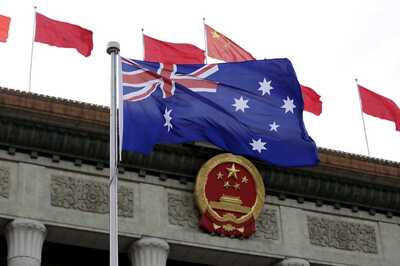
views
BANGALORE: In the realm of existence, we often find ourselves succumbing to brutality and aggression. In fact, it is this obsession with destruction that has brought us much misery. Amidst angst, conflict and fear, we often seek harmony in art. Transporting every individual to a higher realm of consciousness, it has played a pivotal role in nurturing sanity in the perpetual battle between mankind and nature. “Art is like a mirror to the society we exist in. Hence it has the ability to uphold the beauty of an unflinching naked truth. It needs the courage however to be blatant enough for people to sit up and take notice. It need not always be as pleasant as a piece of furniture in the house but could inspire thoughts to be mulled over and considered. It has the ability to shock, pacify and ignite debate,” said artist Moutushi who exhibited some of her recent works as a part of Parables — Visual Essay at Gallery Time and Space recently.The interesting contrast between the innocence of a bird and cruelty of grenades adds a certain eerie mood to the painting titled Chimes of Trouble. Grenade is a central motif that runs through her works that describe the brutal nature of violence.Epitomising destruction, these manmade objects are also seen in Organic II camouflaged as the base of a passion-flower. The artist experiences a constant shift between reality and fantasy throughout her works. In Tussle, she notes: Nature has enough space for man and beast to co-exist in harmony. Yet the duel for empowerment over one another continues unabated as if in testimony of the human trait to overpower and rule. In doing so, the definition is often blurred between urbanity and monstrosity. Exploring the complicated relationship between man and beast, the artist has stumbled upon the key to harmonious existence through art.Delving into the finer aspects of artistic mastery, City Express sets forth on a journey of philosophy and inner peace with Moutushi.Tell us about the theme of ParablesParables is a visual compilation that spans two years in physical time; psychologically though the work bridges a much lengthier period, and reflects the artist’s journey through marriage, motherhood and (ongoing) parenthood. The exhibition featured, in equal measure, descriptions of intimate moments, surreal places and commentaries on social transgressions, woven together in a narrative style that can be intensely direct at times and at others oblique and abstract. The body of work reflects the artist’s attempts to see and evaluate the world with her own senses, and also through the assumed perception of a child.What was the underlying message in Androgen I and Androgen II?The objective of art is not always a vehicle for a ‘message’ to be conveyed. It is definitely a celebration of the visual world. Androgen I & II are beings based on masculine attributes evident in humans, birds and animal forms. It is not possible to categorise them morally or biologically. Their apparent monstrous features sheath a vulnerability that is intrinsic in all living beings.How important is art in our society today?Art is always crucial to human existence but it was never perhaps as approachable as it is today. Any person from any section of the society or nationality could see a work of art just by the click of a button. Art therefore does not even have to be tactile to entertain it’s audience. Its sphere of appreciation has widened such. If not for art we would be nothing more than new age robots programmed to perform the chores of life alone.Where does India stand in contemporary art today?The art fraternity of the world is right now looking towards the South Eastern countries for the coming of Avant Garde’ Art. The presence of Indian Art at international art events and the applause that it receives vociferously signify this trend.


















Comments
0 comment